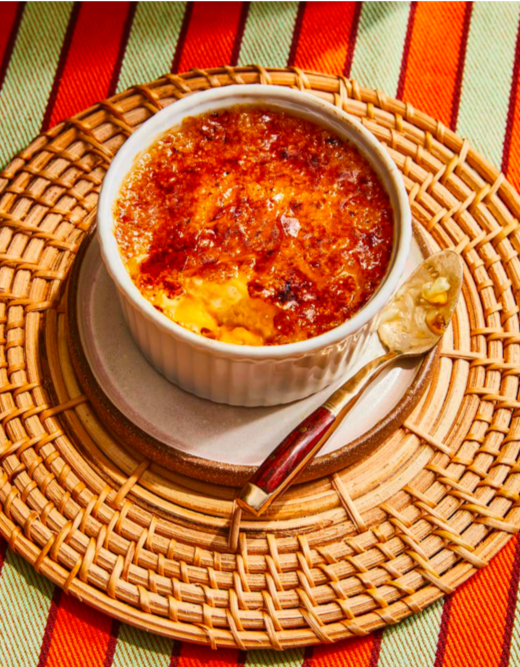
Arlyn Osborne’s cookbook Sugarcane is ripe with Filipino culture, visually appealing imagery and intriguing dessert and pastry recipes for the cook curious to experiment with classics that feature a modern Asian twist. Planning and creating your first cookbook is no simple task for any chef, but Osborne’s attention to detail in design and stylistic touches mimic the carefully chosen ingredients and desserts that populate her stunning first work.
A popular chef on social media, Osborne’s credits her parents with imparting and informing her passion for Filipino and Asian foods, especially on the sweet side of things. Osborne’s dishes all contain Asian or Filipino twists, and feature flavors and textures potentially novel to many readers, such as QQ – which is the element of chewiness prevalent in many Asian sweets and candies.
We spoke with Arlyn about the book and in the spirit of the Valentine’s Day season, we also asked her for the best Sugarcane recipe to make for a memorable first date and she pointed us in the direction of her sensory-laden Mango Sago Crème Brulee, and all the pro tips needed to nail it.

Do you think it’s a good idea to cook or bake something on a first date and why?
If it’s a blind date, no cooking, that could really go south. If it’s somebody that is maybe a friend of a friend then that’s a better set up. Dinner on a first date can be risky because if you don’t know this person at all, conversations can lag and it can definitely be pretty awkward. Dinner is much more of a lengthy time commitment, the scenario would be worse, I think, in your home, than if you were at a restaurant. You’re really trapped that way, but yeah, I think that there are times when cooking for a first date is a good idea, especially if you know the person a little bit. Maybe they’re in your friend group or you’ve been in another setting where you’ve interacted with them a lot. I would say that’s a safer bet.
Do you think that you should try and keep it to something that’s relatively simple, or should you go for it and try something maybe out of your comfort zone?
Oh my gosh, absolutely something simple. Never try to make something complicated or complex. I just think that’s a huge mistake.
Why do you think that would be a mistake?
I think well, one, because it’s too stressful and two, it’s too thirsty! You don’t want to be too desperate. You don’t want to be like, “I made this Thanksgiving dinner for you. Look at this feast.” You want to be a little more low-key, I think. Plus you don’t want to have something too complicated because you really want to get all the cooking stuff out of the way. My opinion is it’s not really fun to cook with someone, so I think if you can find something simple that you prep in advance and minimize the actual cooking activities when your date arrives, the better.
Are there any recipes in your new book that you would suggest as a romantic gesture or sensory experience?
I’m going to say the creme brulee.

What is it about the creme brulee that makes it romantic?
The mango sago brulee is a mashup between a French creme brulee and a very popular Asian dessert called mango sago, it fuses those together. Creme brulee on its own is known for being a romantic and kind of an upscale dessert. It’s a great dish to make for a first date because you can make it ahead of time. It’s a really wonderful sensory experience because it’s got a lot going on, visually, taste and texture.
A creme brulee, even on its own, becomes a performance piece. You can have the brulee totally ready, pull it out of the fridge, get your torch, fire it up, flames and you get to look cool. That’s a really nice effect. The dish itself has a lot of texture and a lot of different temperatures as well. The filling is really silky and creamy, then you have the fresh tangy mango at the bottom of the ramekin and on top and of course you have that really crunchy sugar that you crack with a spoon. It shatters like glass, also it was just torched so it’s not hot, but slightly warm, it’s a really nice dessert.
Would it also be something that would impress a first date?
Absolutely. I think it’s an impressive dish because it seems fancy. A creme brulee is really fancy, and the mango sago is actually easier to make than a traditional creme brulee because you don’t need a water bath; you’re just making the custard on its own and the sago, which is basically like a tapioca. Tapioca is a really unique twist because it adds a lot to the texture. You have the custard, but there are all of these little bouncy bubbles in there. It’s a very chewy and sort of effervescent texture with the silky cream. I would say it’s a really impressive dish.
Could you tell us a little bit more about what sago is, the background behind it and why you picked it for this dish?
So I picked it for the dish because it’s based on the mango sago, which is a dish in Asia that’s very popular. Sago is basically tapioca. I’m sure you’ve heard of tapioca pudding. It’s a term that is actually used very similarly. The terms can be used interchangeably. If we’re being very technical about it, they’re not exactly the same thing. Sago is made from the starch of specific palm trees. Tapioca is made from cassava root, they have the same texture, they are the same size, they’re the exact same thing pretty much. I have seen sago for sale online but the ingredients say cassava, so actually it’s tapioca.
What is your relation to sago/tapioca for people that may not know the origins of the ingredient?
There’s a lot of tapioca and chewy texture in Asian cooking. Of course, I’m sure you’ve heard of bubble tea or Boba, that’s just another form of tapioca. I would say that the most popular version of mango sago is the Hong Kong version, that’s where it’s most well known. However, there are a lot of other countries in Asia that have their version of mango sago; Taiwan, Malaysia, and then the Philippines of course. My Mom is from the Philippines and mango sago is just something that’s a very typical dessert there. Some people think it’s kind of a drink. I’ve seen some that are more liquidy than others, and then it’s like a pudding in different circumstances.
So where do you go to find it? Are there stores where you can go and purchase it or is that something that you have to buy online?
No, you don’t have to buy it online. If you go to any Asian supermarket, it doesn’t specifically have to be a Filipino grocery store. You can go to H Mart, that’s the popular one. Even if you just go to a small mom and pop Asian grocery store, they’re going to have some form of sago or tapioca there for you to buy. You can totally just sub in tapioca. Tapioca is even what I use because it’s just easier for me to get.
What mango do you recommend using and how do you know if a mango is ripe?
For this recipe, I really like the Ataulfo mangoes. They’re the yellow ones. Sometimes they’re called honey mangoes or champagne mangoes. You’ll see that on the label sometimes at the grocery store. I really like that because one, it’s probably the most similar to the Manila mango, which is the mango of the Philippines. It’s also called the Carabao mango, but it’s just a really sweet, juicy, flavorful mango more than the green Tommy Atkins variety. The yellow mangoes have a nice soft texture too. I just love that flavor so much, it really goes nicely in the sago brulee. To tell if a mango is ripe, I just give it a little squeeze. It should give a little bit when you squeeze it, but it shouldn’t be too mushy, or it could be overripe.
For the coconut milk in the recipe, is there a specific brand that you recommend? If you end up using different mangoes than an Ataulfo, is the dessert going to suffer?
It isn’t going to suffer if you choose a different type of mango, but it might not be as sweet because I don’t think that the other type of mango, the Tommy Atkins, is as sweet and it also has a little bit different texture. But no, it’s not going to suffer. It’ll be fine.
For the coconut milk, I am very particular about the coconut milk that I use. Actually, there’s so many brands of coconut milk and they are not all created equal. Some are really watery, some are really thick. It’s so drastic, but I tend to go for a Taste of Thai. I think it’s really nice. You can find it at pretty much any supermarket. I like it because it’s the perfect consistency, it’s not too creamy, but it’s not really watery either. My second favorite brand, if you can’t find that one, is Chaokoh, which is something you would have to go to an Asian supermarket to get.

Is there a torch that you’d recommend? What if you don’t have a torch?
I actually really like to use a handheld propane tank, the one you would find from Home Depot or a home improvement store. It’s way better than those little handheld toy sized ones that are specifically for creme brulee. With those, the flame dies super quick. If you don’t have a torch, you can just use a broiler.
Your recipe uses turbinado sugar, why did you pick that type of sugar? Are there other types of sugar you could substitute?
First off, turbinado sugar is not the same as granulated sugar, it’s like a finishing sugar. It’s really coarse and it’s extra crunchy. It’s not something that you’d mix into a batter or anything, but it’s something that you would use to dress up your desserts, like sprinkling it over scones or the crust of a galette. It adds a nice shimmer and a really nice crunch. It’s usually labeled raw or natural, like sugar in the raw, which is interesting because it’s not really raw because it has a little bit of molasses in it and that’s what gives it that caramel color. Turbinado has added color so you get a more pronounced golden topping and it’s really crunchy and melts easily. If you don’t have that, you could definitely use granulated sugar – that’s going to work fine. A little pro trick; even if you’re using granulated sugar, torch the sugar and then add another layer on top, so you have two layers. It really emphasizes that glassy top and you get an even more dramatic crack when you bust your spoon into it.
So you mentioned there’s a lot of different temperatures within the dessert. What is it about that that makes it really great or great for a first date?
Yeah, I love a dessert that has different temperatures. I think that’s such an interesting concept when it comes to food just in general because it’s so unexpected. It’s kind of the same idea of when you have a hot piece of a chocolate lava cake or something and it has a scoop of ice cream next to it. The pair together is so great. This mango sago brulee isn’t as dramatic as that, but it’s still there and it still adds dimension to the dish. It’s a really nice feature and again, very unexpected.
So if you’re making this for, or on a first date, is it possible that you’re setting the bar a bit high?
No, I don’t think so, it’s actually perfect. It’s impressive enough, but you’re not showing all of your cards at once in the beginning, which I don’t think you should do. I don’t think you give your best on the first date, there’s still room to take it up a notch if you need to.
What is one element, or ingredient, or part of this process that you really have to be careful about? Is there one thing that could send it off the rails?
I would definitely say tempering the eggs is the trickiest part. When you’re making the custard, it’s enriched with eggs – the eggs also thicken it. You’re going to add the warm coconut milk into the egg yolks. You don’t want to just add it all at once or too fast because then you’ll end up scrambling/cooking the eggs. That’s really the trickiest part, just kind of doing that slowly.
What would you say is unique about this dessert besides the mango sago that makes it different from your traditional creme brulee?
What really makes this dessert different and special is the tapioca, it’s such an interesting texture to have in there. I have other recipes in my cookbook, I have a banana pudding that also has tapioca and it really adds that nice chewy flavor and it’s all about these little bouncy beads. I love chewy things. I love boba bubble tea and that sort of thing. There’s actually a term, an Asian term for that and it’s called QQ, like a texture, and it’s chewy.
How To Make The Mango Sago Creme Brulee, According To Arlyn Osborne

Ingredients
MAKES 6 SERVINGS
- 14 oz. (400 g) diced yellow Ataulfo mango (about 2 cups)
- 5 cups (1200 g) water
- 1⁄4 cup (48 g) small pearl tapioca
- 1 cup (240 g) canned unsweet- ened coconut milk, divided
- 1 tablespoon (8 g) cornstarch
- 2 large egg yolks, at room temperature
- 1⁄4 cup (50 g) granulated sugar
- 1⁄4 teaspoon kosher salt
- 1 tablespoon (14 g) unsalted butter, at room temperature
- 1 tablespoon (15 g) fresh lemon juice
- 12 teaspoons (60 g) turbinado sugarSpecial Equipment
- Six 4 oz. (120 ml) ramekins Kitchen torch (see Note)
Note: If you don’t have a kitchen torch, you can use your oven broiler to caramelize the sugar.Method
- Place six 4-ounce (120 ml) ramekins on a sheet pan. Divide the diced mango evenly among the ramekins.
- In a large saucepan, bring the water to a boil over high heat. Stir in the tap- ioca and bring back to a boil.
- Cook, stirring occasionally, until tender and translucent, about 20 minutes.
- Strain the tapioca through a fine-mesh sieve and rinse with cold water. Set aside.
- In a medium bowl, whisk together 1⁄4 cup (60 g) of the coconut milk and the cornstarch. Whisk in the egg yolks and set beside the stovetop.
- In a small saucepan, whisk together the remaining 3⁄4 cup (180 g) of coconut milk, the granulated sugar, and salt. Heat over medium heat until warm and steaming, 3 to 4 minutes. Turn off the heat.
- Gradually whisk the warm coconut milk mixture into the yolk mixture. Pour it back into the saucepan and cook over medium heat, whisking constantly, until it’s thick enough to coat the back of a spoon and has the consistency of a smooth pourable custard (not like a pudding), about 3 minutes. (You’ll think it looks too thin, but the tapioca will add just enough body).
- Remove from the heat and whisk in the tapioca, butter, and lemon juice.
- Divide the mixture evenly among the ramekins and cover with plastic wrap. Refrigerate until chilled and set, at least 6 hours, but overnight is best.
- Before serving, let the ramekins sit out at room temperature for 10 minutes. Sprinkle each ramekin with 2 teaspoons (10 g) of turbinado sugar.
- Caramel-ize the sugar with a kitchen torch.
